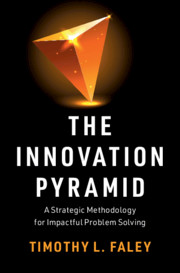Book contents
- The Innovation Pyramid
- The Innovation Pyramid
- Copyright page
- Dedication
- Contents
- Figures
- 1 Introduction
- Part I Innovation Design and Execution
- Part II The Diverge–Organize–Converge Process
- 8 Diverge–Organize–Converge Process Overview
- 9 Diverge
- 10 Organize
- 11 Converge
- 12 Book Summary
- Book part
- Bibliography
- Index
8 - Diverge–Organize–Converge Process Overview
from Part II - The Diverge–Organize–Converge Process
Published online by Cambridge University Press: 30 December 2020
- The Innovation Pyramid
- The Innovation Pyramid
- Copyright page
- Dedication
- Contents
- Figures
- 1 Introduction
- Part I Innovation Design and Execution
- Part II The Diverge–Organize–Converge Process
- 8 Diverge–Organize–Converge Process Overview
- 9 Diverge
- 10 Organize
- 11 Converge
- 12 Book Summary
- Book part
- Bibliography
- Index
Summary
An overview of the creativity-based DOC (Diverge Organize Converge) Process is described in this chapter. The DOC Process is an important sub-process necessary to reduce the design stages of The Innovation Pyramid to practice. It will be applied multiple times, in a variety of different ways, during the innovation design stages. The DOC Process can also be applied to a multitude of other non-innovative challenges. The DOC Process has three distinct components: divergent thinking, organizing and convergent thinking. It is the combination of all three that makes the method powerful. While most are familiar with divergent thinking, particularly brainstorming new solution ideas, the DOC Process is as useful for identifying root-cause problems as it is for ideating new solutions. The Diverge step expands from the original solution idea or problem situation. The second step of the process is the often ignored Organize step. Once the Organize step is completed, the process moves onto the Converge step. Converge narrows the organized concepts down to the “best.” Criteria for choosing “the best” problem or solution must be conscious and public. Unless agreed-upon criteria is defined for choosing “the best,” each of us will apply our own measures, ensuring a chaotic outcome.
Keywords
- Type
- Chapter
- Information
- The Innovation PyramidA Strategic Methodology for Impactful Problem Solving, pp. 159 - 169Publisher: Cambridge University PressPrint publication year: 2021



